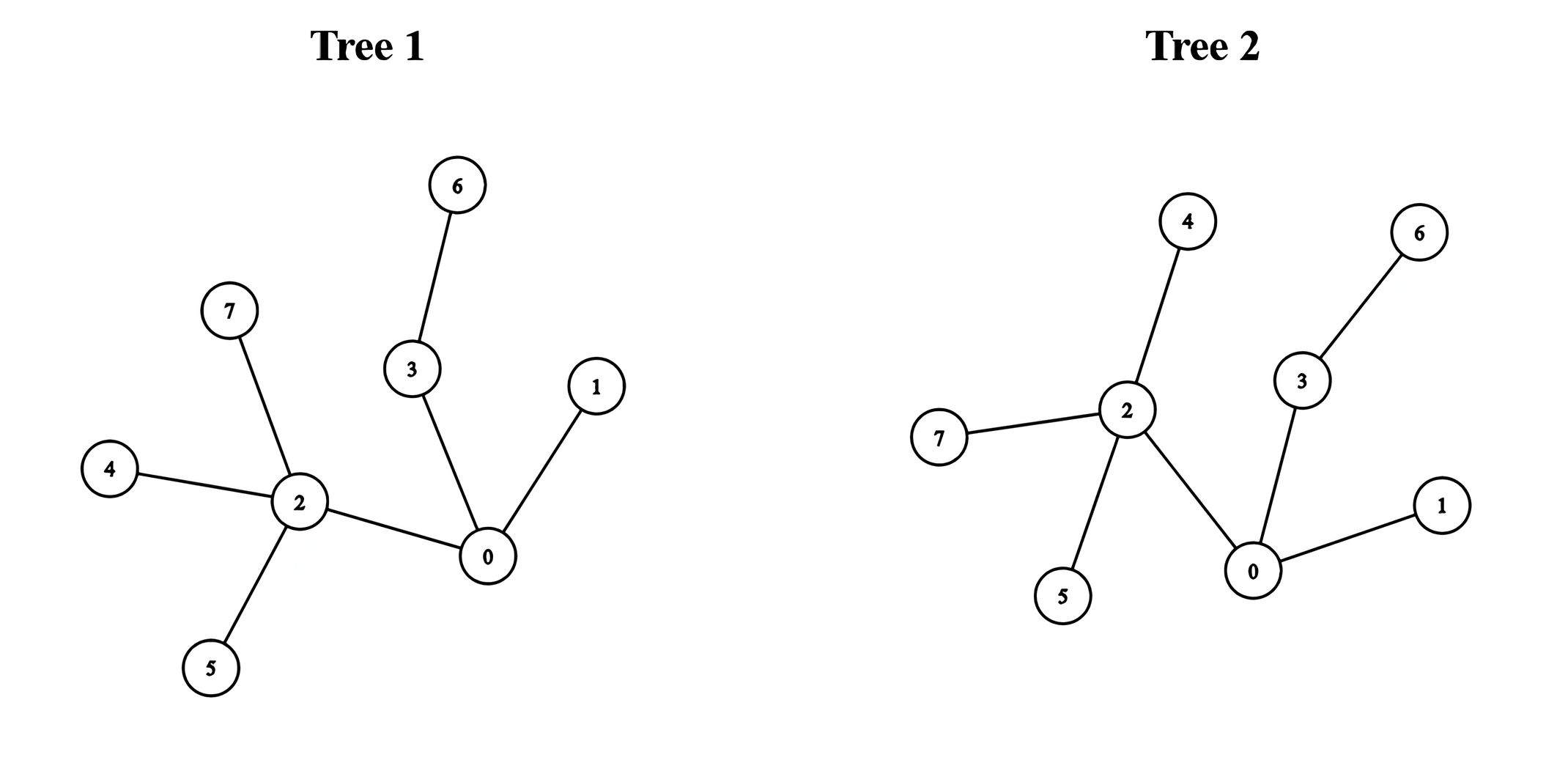3203. Find Minimum Diameter After Merging Two Trees
Description
There exist two undirected trees with n and m nodes, numbered from 0 to n - 1 and from 0 to m - 1, respectively. You are given two 2D integer arrays edges1 and edges2 of lengths n - 1 and m - 1, respectively, where edges1[i] = [ai, bi] indicates that there is an edge between nodes ai and bi in the first tree and edges2[i] = [ui, vi] indicates that there is an edge between nodes ui and vi in the second tree.
You must connect one node from the first tree with another node from the second tree with an edge.
Return the minimum possible diameter of the resulting tree.
The diameter of a tree is the length of the longest path between any two nodes in the tree.
Input: edges1 = [[0,1],[0,2],[0,3]], edges2 = [[0,1]]
Output: 3
Explanation:
We can obtain a tree of diameter 3 by connecting node 0 from the first tree with any node from the second tree.
Example 2:
Input: edges1 = [[0,1],[0,2],[0,3],[2,4],[2,5],[3,6],[2,7]], edges2 = [[0,1],[0,2],[0,3],[2,4],[2,5],[3,6],[2,7]]
Output: 5
Explanation:
We can obtain a tree of diameter 5 by connecting node 0 from the first tree with node 0 from the second tree.
Constraints:
1 <= n, m <= 105edges1.length == n - 1edges2.length == m - 1edges1[i].length == edges2[i].length == 2edges1[i] = [ai, bi]0 <= ai, bi < nedges2[i] = [ui, vi]0 <= ui, vi < m- The input is generated such that
edges1andedges2represent valid trees.
Solutions
Solution 1: Two DFS Passes
We denote \(d_1\) and \(d_2\) as the diameters of the two trees, respectively. Then, the diameter of the merged tree can be one of the following two cases:
- The diameter of the merged tree is the diameter of one of the original trees, i.e., \(\max(d_1, d_2)\);
- The diameter of the merged tree passes through both of the original trees. We calculate the radii of the original two trees as \(r_1 = \lceil \frac{d_1}{2} \rceil\) and \(r_2 = \lceil \frac{d_2}{2} \rceil\), respectively. Then, the diameter of the merged tree is \(r_1 + r_2 + 1\).
We take the maximum of these two cases.
When calculating the diameter of a tree, we can use two DFS passes. First, we arbitrarily select a node and start a DFS from this node to find the farthest node from it, denoted as node \(a\). Then, we start another DFS from node \(a\) to find the farthest node from node \(a\), denoted as node \(b\). It can be proven that the path between node \(a\) and node \(b\) is the diameter of the tree.
The time complexity is \(O(n + m)\), and the space complexity is \(O(n + m)\), where \(n\) and \(m\) are the number of nodes in the two trees, respectively.
1 2 3 4 5 6 7 8 9 10 11 12 13 14 15 16 17 18 19 20 21 22 23 24 25 26 | |
1 2 3 4 5 6 7 8 9 10 11 12 13 14 15 16 17 18 19 20 21 22 23 24 25 26 27 28 29 30 31 32 33 34 35 36 37 38 39 | |
1 2 3 4 5 6 7 8 9 10 11 12 13 14 15 16 17 18 19 20 21 22 23 24 25 26 27 28 29 30 31 32 33 | |
1 2 3 4 5 6 7 8 9 10 11 12 13 14 15 16 17 18 19 20 21 22 23 24 25 26 27 28 29 30 31 | |
1 2 3 4 5 6 7 8 9 10 11 12 13 14 15 16 17 18 19 20 21 22 23 24 25 26 27 28 29 | |




